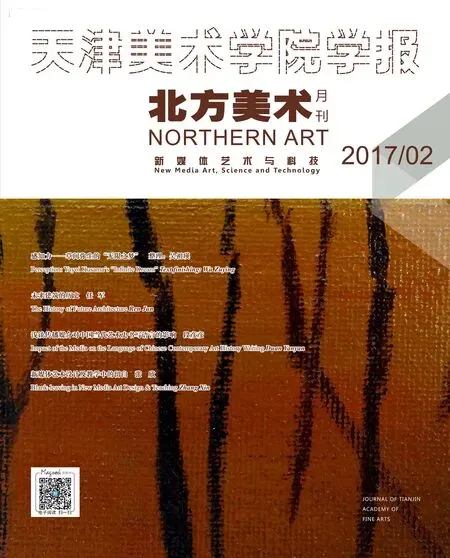画面的空间与观看
——以丁托列托作品《耶稣为门徒洗脚》为例
禾 苗 文 岳中生 译
丁托列托(1518—1594)原名为Jacopo Robusti,是文艺复兴晚期威尼斯画派的重要画家和代表画家之一。这位几乎终生驻守在威尼斯的“小染色匠”(他的意大利名字“Tintoretto”之原意,因为其父亲的职业是染色匠),有着“米开朗琪罗的素描和提香的色彩”①的雄心和才能,在五十多年漫长的创作生涯中,完成了五百多幅作品。
在他众多的作品中,有一类作品具有这样的特点:1.为特定的公共场所订制而创作;2.构图呈非中心对称结构;3.为大画幅②的宗教题材作品。
Tintoretto (1518-1594), originally known as Jacopo Robusti, was one of the greatest painters of the Venice School in the late Renaissance.The“little dyer” (which “Tintoretto” suggests in the Italian language, because his father was a dyer), who spent almost his entire life in Venice, had ambition and potential to produce “Michelangelo’s drawing and Titian’s color.”1And he produced more than 500 works through five decades of creation.
Among his vast oeuvre was such a type of works which were: 1)commissioned for particular public spaces; 2) non-centrosymmetric in composition; and 3) large-sized2and religion-themed.

图1 丁托列托 耶稣为门徒洗脚 布面油画 228×533cm 1548年 马德里普拉多博物馆Fig.1 Christ Washing the Feet of His Disciples, Tintoretto, Oil on Canvas, 228×533cm, 1548, Prado National Museum,Madrid
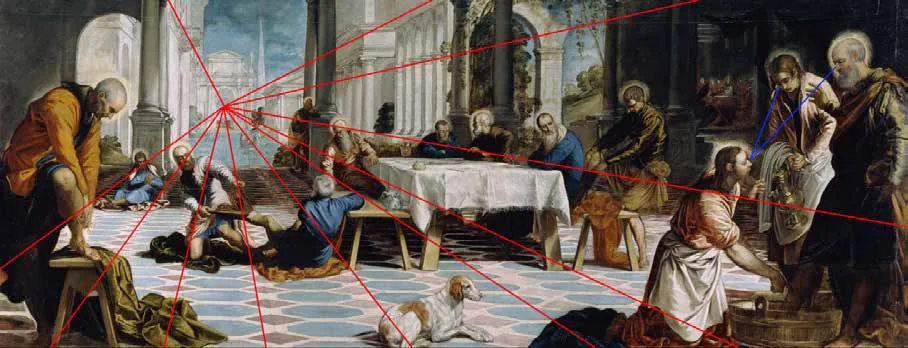
图2 《耶稣为门徒洗脚》动作指向示意图与线性透视图Fig.2 Action-direction schematic and linear perspective: Christ Washing the Feet of His Disciples
一、画面空间的特点
下面就以丁托列托的《耶稣为门徒洗脚》(Christ Washing the Feet of His Disciples)(图1)为例,先从画面中的空间结构入手,分析观看这类作品所需要把握的规律。
《耶稣为门徒洗脚》(228×533cm,1548年, 西班牙马德里普拉多博物馆)(图2)中,丁托列托设置了两个透视点,这样做的目的是为表达多重含义。根据在画面中的远近位置,图中有三组人物:位于画面最右边的这组人物,三个人物的头部构成锐角三角形的关系,两位圣徒面向耶稣,根据他们站立的朝向和姿态,以及耶稣头部所在锐角的顶端位置,耶稣的头部自然而然成为视觉的焦点所在(图2中以蓝线标示)。也就是说,第一个焦点在耶稣的头部,这也是《耶稣为门徒洗脚》整个画面的主题所在。“这个消失点意指基督的人性光辉和为人类的自我牺牲。”[1]24第二个消失点在由建筑结构形成的空间里(图2中以红线标示):画面的中间和靠左部分的背景是连续的建筑,中景中水平排列着由五对柱子支起的凉廊,居于画面中间(画面空间的右边)的中景是一座双层建筑,一直纵深延伸到与凉廊垂直的拱门处去。这座双层建筑第一层由多利克柱式装饰,透视结构的最远处则有三角山墙和有着高台的神庙。这个景深的幻象通过各种不同的建筑特征和比例,逐渐向地平线隐去。这个消失点在地平线上,意指“上帝永恒的荣耀。”[1]24
塞巴斯蒂亚诺·塞利奥(Sebastiano Serlio)于1537年至1547年在威尼斯出版的《建筑的一般规则》有很大的影响,共有七卷,其中第二卷中对透视、剧院结构、场景的研究都被认为是维特鲁威《建筑十书》的拓展论述。他对街景的设计利用了街旁的宫殿和教堂、门廊和门龛,所有这些透视使舞台上呈现出深远的景象。丁托列托对当时的戏剧实践非常着迷。他经常与戏剧圈的人合作,一直与剧作家卡尔莫(Calmo)和阿莱蒂诺(Aretino)保持密切的联系。当然还有版画家和雕刻家马可里尼(Marcolini),他是1537年《建筑的一般规则》出版的负责人。这样,可以说丁托列托对塞利奥关于透视场景的论述是很熟悉的。[1]23
《耶稣为门徒洗脚》中,丁托列托在背景中复制了塞利奥的例子,为他的画面设计了一个恰当的背景,表达基督救赎人类的使命这个戏剧性事件。在凉廊内外穿插的植被不仅仅是装饰,也是为了展现空间的深度,表达象征意义。如果以画面上的地砖以及双层建筑和凉廊等建筑元素做出透视线的话,消失点位于处在地平线位置上的希腊式庙门之中;反过来看,观看者所处的位置也恰好在从这个消失点发散出来的区域。画面上的地砖的纹样的线条也在视觉上得到延展,直至教堂中的真实地面。这样,图像上的虚拟空间延伸到真实空间,平面上的二维空间与现实中的三维空间浑然一体:也就是说,作为戏剧观众的观看者,感觉上与此时在舞台上的“演员们”一起,都处于同一空间之中。
I.Space Features in Tintoretto’s Paintings
WithChrist Washing the Feet of His Disciples(Fig.1) as an example,the author will start from its spatial structure before analyzing laws on how to view such works.
In this painting (228×533 cm, 1548, Prado National Museum, Madrid,Spain) (Fig.2), Tintoretto devised two perspective points to express multiple meanings.By their positions herein, far or near, there are three groups of characters in it.For the group on the far right, the heads of the three figures form an acute triangle, in which two disciples face Christ,whose head naturally becomes the visual focus (as blue lines show in Fig.2).That is to say, the first focus is Christ’s head, where lies the theme of the whole piece.“At this vanishing point, he alludes to Christ’s humility and His sacrifice for humankind.”[1]24The second vanishing point is in the space formed by the architectural structure (as red lines show in Fig.2): In the background of the middle and left parts of the painting are a sequence of buildings.In the middle distance lies a loggia of five bays supported by pilasters.And the mid-shot of the middle (the right of the picture space) is a two-storey edifice, which extends lengthways until the archway vertical to the loggia.The first storey is decorated with Doric columns, and at the furthest of the perspective structure stands a high-platform temple with pediments.Then the illusion of deep space is suggested through a variety of architectural features and proportions gradually diminishing toward the horizon.And this vanishing point is on the horizon, which suggests the “eternal Glory of God.”[1]24
Sebastiano Serlio publishedGeneral Rules of Architecturebetween 1537 and 1547 in Venice, which was very inf l uential.It includes seven volumes, in which volume 2 involves his research of perspectives,theatrical structure and scenes, and is deemed an extended treatise ofThe Ten Books on Architectureby Vitruvius.Serlio’s street scenery design took advantage of nearby palaces and churches, porches and gate recesses; all these perspectives present a spatial depth on the stage.Tintoretto, who was fascinated with the illusion of contemporary theatrical practices, constantly associated with the theatre circle and kept close contact with the playwrights Calmo and Aretino and, of course the printer and engraver Marcolini, who was responsible for publishingGeneral Rules for Architecturein 1537.So, it is safe to say that Tintoretto was quite familiar with Serlio’s treatise on perspective scenery.[1]23
While creatingChrist Washing the Feet of His Disciples, Tintoretto reproduced Serlio’s illustration in the background, and designed a suitable backdrop for his work, the dramatic event alluding to Christ’s mission to save humankind.The plants winding through the loggia serve not only as an ornament, but also as a medium of displaying the depth of space, quite symbolic.If perspective lines are drawn for the architectural elements in the image, e.g.the tiled floor, the two-storey edifice, the loggia, then the vanishing point lies in the Greek-style temple portal situated on the horizon.In other words, the position where the viewer stands is precisely within the area corresponding with the vanishing point.Visually, the fl oor-tile lines seem prolonged until reaching the true fl oor of the church.Therefore, the virtual space in the image extends into the real one; and the 2-D space in the painting plane and the 3-D space in reality blend into a harmonious whole.To put it another way, the viewer as the theater audience develops a sense of togetherness with “actors/actresses” on the stage—being in the same space.

图3 从教堂左后方看向祭坛的方向的场景照片,威尼斯圣马阔拉教堂Fig.3 The altar, seen from the left rear, the Church of San Marcuola, Venice (photo)
二、画面空间与观看位置之间的关系
丁托列托所画的《耶稣为门徒洗脚》的原始放置场所是在威尼斯的圣马阔拉教堂(Chiesa diSan Marcuola)的礼拜堂里,现在居于祭坛右侧的《耶稣为门徒洗脚》是卡洛·里多尔菲(Carlo Ridolf i,《丁托列托传》的著者)[4]所画的复制品,根据里多尔菲的记载,原作是17世纪中叶从圣马阔拉教堂搬走的。这幅作品与他的另一幅作品《最后的晚餐》(157×443cm,1547年,威尼斯圣马阔拉教堂)面对面而挂置,《最后的晚餐》在祭坛左侧,里多尔菲所画的《耶稣为门徒洗脚》现在居于祭坛右侧,丁托列托的原作在马德里的普拉多博物馆内。③
丁托列托对公共委托订制作品的工作方式总是对作品放置地点进行仔细研究。距离之间的相互关系、高度和光线都是建构空间整体性的因素,不管是在画框之内还是画框之外的整体性。[1]33《耶稣为门徒洗脚》中的路面显示了相同的菱形和八角形相互交替,平行于画面的建筑元素向后延伸,形成不同的层次,好像丁托列托为了画面形式特地建立了小模型,并对它们进行重复使用。被复制的单元各个连接,就像制造出一系列连续的舞台,并制造出空间的深度感。
《耶稣为门徒洗脚》这幅作品的透视中心偏离画面的对称中心,主视点在礼拜堂外侧面的位置。圣马阔拉教堂始建于12世纪,重建于17世纪,18世纪完成内部的重建(教堂正立面至今没有完成)。丁托列托受委任创作此画,并于1548—1549年完成。由于此画是受教堂委任而创作的,所以当时他对画面的设计是为现在其复制品所处的位置而完成的。
II.Space vs Viewing Position
The original location of Tintoretto’sChrist Washing the Feet of His Discipleswas in a chapel of the Church of San Marcuola, Venice.Currently, the piece bearing the same name on the right of the altar is a replica by Carlo Ridolfi, authorof The Biography of Tintoretto.[4]According to Ridolf i, the original piece was removed from the church in the mid-17th century.On the left of the altar hangs hisThe Last Super(157×443 cm, 1547, the Church of San Marcuola, Venice).In fact the original Tintoretto is in Prado National Museum, Madrid.3
Tintoretto’s preparation for a public commission usually began with a careful investigation of the location where the painting was to be placed.Mutual relations between distances, height and sunlight are all elements contributing to spatial integrity, no matter whether those elements were inside or out of the frame.[1]33In the painting, the fl oor indicated the same interlacing rhombuses and octangles, which go parallel to architectural elements in it, extending backward and forming different layers as if the artist had purposefully built a small model for the form of the painting and used it over and again.These repeated, interconnected units are like a continuous series of stages, all creating a sense of deep space.
The perspective center ofChrist Washing the Feet of His Disciplesdeviates from the symmetrical center of the piece, and the principal viewpoint falls somewhere outside the chapel.The Church of San Marcuola was built in the 12th century, and reconstructed in the 17th century, whose interior was not completed until the 18th century (and whose facade has not been completed so far).Since Tintoretto had been commissioned by the church to create this piece (and he finished it between 1548 and 1549), his design was intended for the location where the replica hangs.
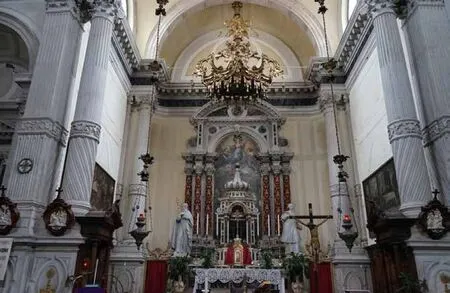
图4 从祭坛的正前方看向礼拜堂的场景照片,威尼斯圣马阔拉教堂Fig.4 The chapel, seen right from the front of the altar, the Church of San Marcuola, Venice (photo)
显然,丁托列托非常清楚:作为信众的观看者只能在祭坛的前方,并且只能从画的左侧某些区域进行观看。图3是威尼斯圣马阔拉教堂内部,从教堂左后方看向祭坛的方向的场景照片。我们可以根据里多尔菲这幅《耶稣为门徒洗脚》的复制品,设想此刻丁托列托的原作在此处的情形:虽然这幅复制品在细节上与原作有所不同,但是在整个画面结构上遵循了原作在空间结构上的设置。教堂被重建以后,礼拜堂内祭坛的两侧有悬挂的圣器,会遮挡观看画面的视线。作者将遮挡物(垂吊的圣器)去除,将原作放在礼拜堂的右侧墙面,此时复制品的位置也就是原作的原始位置。这样,还原在丁托列托的时代站在祭坛前方恰当的位置观看此画的场景:由于祭坛所在的空间较窄,如果站在与祭坛前方稍远一点的位置,这幅画将被其左边的柱子遮挡,令人无法完整地进行观看(图4)。作品被置于祭坛右侧,观看者在教堂的本堂对这幅画进行观看时,位于祭坛的台阶之下,视角只能从画的右侧下方切入。图5是利用建模工具还原原作在此礼拜堂的视觉效果图。这样,虽然基督耶稣并不位于画面的中间位置,但是从祭坛前方观看画面时,耶稣反而位于距离观看者的视点最近。其次,由画面中的建筑元素和能够体现景深的其他装饰元素形成的空间结构,照应了教堂中实际空间中的建筑元素(如画面中重复出现的拱形凉廊与教堂实际空间中的拱门),使从特定视角进行观看的观众融入画面之中。由此,画面中的空间与现实空间形成一致性和整体性。
Obviously, the artist was well clear that as a worshiper, the viewer can stand looking only in front of the altar and from somewhere on the left of the piece.Fig.3 shows the interior of the church, when the altar is seen from the left rear of it.We may imagine what the Tintoretto was originally like, based on Ridolf i’s replica, which, though different from the former in details, must have retained its spatial arrangement.Incidentally, holy vessels were hung on both sides of the altar after reconstruction, which might block the sight of the viewer while he was watching the image.Therefore, the author removed the obstructions(hanging holy vessels) and placed the original on the chapel’s right wall.Then the position of the replica is where the original work was.Now when we try to reconstruct how the image was looked at by a viewer from an appropriate position in front of the altar, we will find that: given the limited space around the altar, the painting cannot be fully watched(Fig.4) if the viewer stands a little further away from its front, because the piece will be obstructed by the pillars on the left.However, if the image is located on its right, the viewer’s eyes can approach the work only from the right bottom of the piece when he stands in the nave and below the steps leading to the altar.Fig.5 shows a visual rendering of simulation of the original with modeling tools.By doing so, though Christ Jesus is not placed in the center, He seems closer to the viewer’s point of sight if the viewer watched the painting from the front of the altar.Secondly, the spatial structure created by the architectural elements in the piece and other decorative elements expressing deep space is in accordance with those actual architectural elements in the church (e.g.repeated vaulted loggias in the image and the actual archways in the church), which transports the audience viewing from a particular angle into the piece.Hence a sense of consistency of the painted space with the actual space as well as a sense of integrity.
III.Tentative reconstruction of the original scene
From January to May 2007, the show “TINTORETTO” was open in Prado National Museum, Spain, including his 65 works.Before the event, the positioning of the art works had been analyzed on the basis of his peculiar compositions, and was readjusted correspondingly.Miguel Falomir, editor of the exhibition catalogue said, “Of course, no exhibition can replace a visit to Venice.”[3]“A visit to Venice” here meansin situ,that is, “on site.”
三、对原始场所进行尝试性还原
2007年1月至5月在西班牙普拉多博物馆的展览“丁托列托”,包括65幅作品。这个展览在作品的摆放角度上,已经根据丁托列托式的构图进行分析,并在放置位置上做了相应的调整。编辑这个展览画册的米盖尔·法罗米尔(Miguel Falomir)说:“当然,没有展览可以替代一趟在威尼斯的参观。”[3]他在这里指的“在威尼斯的参观”就是指in situ,即“在现场”。
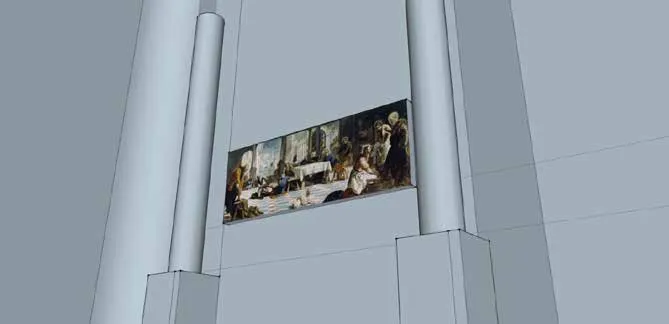
图5 《耶稣为门徒洗脚》场景模拟视觉效果图Fig.5 Visual rendering of a simulated scene: Christ Washing the Feet of His Disciples

图6 从祭坛左前方看向《耶稣为门徒洗脚》(里多尔菲的复制品)场景照片,威尼斯圣马阔拉教堂Fig.6 Christ Washing the Feet of His Disciples(Ridolfi’s replica), seen from left front of the altar, the Church of San Marcuola, Venice (photo)
这次展览的作品除了普拉多本身馆藏的丁托列托作品以外,还有从威尼斯的会堂(Scuola)和私人收藏借来的作品。当某些作品被放在普拉多博物馆时,是它们第一次从光线幽暗的威尼斯的教堂被挪放到宽敞明亮的场所,被并置和交叉对比,对这些作品的近距离研究以此得以实现。评论家以往对丁托列托有各种偏见,例如“漫不经心”“创作速度过快(prestezza)”此类的负面评价。这个展览通过对作品的合理展示,消除这些误解,并在展示空间方面尽可能与画家创作时考虑的作品挂置空间相符合。“这个展览提醒人们注意了丁托列托在图像方面惊人的才能,和在构图方面的用心。”[2]
Apart from the Tintoretto’s paintings in the collection of the museum,there were also loan works from Venicescuolasand private collection as well.When some of them were on display there, it was the first time for them to have been transferred to a spacious and bright placefrom that dark Venice church, juxtaposed and compared, which made a short-distance study possible.Admittedly, critics bore prejudice against Tintoretto with negative comments like “a lack of diligence” and an allegedly “too-fast production (prestezza).” Therefore, the exhibition helped to clear up previous misunderstandings of him through reasonable exhibition, and tried every means to set up a space similar to what the artist intended.“The exhibition reminds people of Tintoretto’s astounding pictorial intelligence and carefulness with which he conceived his compositions.”[2]

图7 《耶稣为门徒洗脚》局部,地砖部分Fig.7 Detail of Christ Washing the Feet of His Disciples, the tiled fl oor section
丁托列托所处的时代,威尼斯的戏剧异常繁荣。自16世纪,威尼斯以不计其数的演出而闻名于世。娱乐被共和国用来宣扬它的政治——宗教意识形态,也用来扩大总督及其办事处的声望和权力。1556年至1607年之间,在威尼斯举行了171次庆典。[1]12在狂欢节期间,相应的专业人员会对这些演出负责,这些演出会大大增强社区的凝聚力和稳定性。观看大量的庆典毋庸置疑使丁托列托画面的剧情变得丰富起来。
当时有三个剧团在戏剧方面最有名气。提香为一家剧团设计道具和布景,瓦萨里在1542年被请来做一部剧首演的舞台设计。作为“Calze剧团”(Compagnie delle Calze)的舞台美术设计师,丁托列托除了被指定给一些戏剧设计一些道具和服饰以外,也由此经验得到空间设置方面的独特的工作方法:利用模拟舞台建立最能恰当展现空间结构的构图。他把做好的人像模型放在用纸板做成的建筑模型中或挂在空间,用烛光照明,研究它们的位置的远近和深度、空间感及光的效果。这些用黏土或者蜡创作出的人物形象被放进木头或者纸盒做的舞台的模型,并在侧旁切开口投入射光,这样丁托列托可以反复重新组合人物,直到他自己满意为止。在充分把握丁托列托式绘画的空间特点以后,根据这些与空间结构有关的规律,建立模拟场景还原丁托列托作品所处的原始空间,不但可以对画家的本意进行最大程度的解读,也可以对某些场所的复原或重建提供依据。
丁托列托1548年为威尼斯的圣马阔拉教堂完成《耶稣为门徒洗脚》之后,教堂在17世纪又进行过翻修。教堂主殿和礼拜堂的地面现在为黑白相间的地砖(图6),而当时是何样貌,已无从考证。然而,我们可以根据丁托列托的画中建筑元素与实际场所保持样式和摆放角度的一致性这一特点,来模拟圣马阔拉教堂内的地砖在17世纪重修之前可能的纹样。
《耶稣为门徒洗脚》中,耶稣在画面右下角里观看者最近的位置,其身后铺满着大面积的三色地砖(图7),形成八角形和正方形的纹样,加以进行几何透视变形,布满整个凉亭。所有画中的人物都在这些砖面之上,犹如一块几何纹样的地毯,把前景和中景发生的故事与远景中的室外景物进行理性的分割。
在丁托列托其他诸多作品中可以发现,丁托列托习惯在画面中加入与作品所在的实际空间中相同的画中建筑元素,以保持画面的连续性和对观看者的带入感。在此,我们对圣马阔拉教堂的礼拜堂地面进行尝试性的复原,得到《耶稣为门徒洗脚》在圣马阔拉教堂的模拟场景图(图8),采用的是教堂左侧后方的视角。可以设想,当观看者走到祭坛前方观看作品时,画面上的地板一直蔓延到他本人所处的真实空间的脚下,画面中的空间由此得到延续,观看者本身会具有身临其境的感受。
In Tintoretto’s time, drama boomed extraordinarily in Venice.Beginning from the 16th century, the city got its fame for countless performances.Entertainment was used to spread the republic’s political and religious ideology and to enhance the reputation and authority of the governor and his office.Between 1556 and 1607, there were 171 celebrations that took place in Venice.[1]12During the carnivals ,professionals would be responsible for these performances, which would tremendously strengthen the community belongingness and stability.Undoubtedly, a large number of performances that the artist had watched enriched his plot in paintings.
At that time there were three renowned troupes in drama.Titian was responsible for stage property and setting design for one of them;Giorgio Vasariwas invited to design the stage for the premiere of a play in 1542.As a stage art designer of Compagnie delle Calze, Tintoretto,apart from being designated to design property and costumes, acquired more experience and figured out unique working methods of space layout: use of a simulated stage to establish a composition which best illustrates spatial structure.He put ready-made dummies into building models made of cardboard or hung them, and gave them candlelight to study their different positions, far and near, depths, the sense of space,and light effect.Such dummies made of clay or wax were put into stage models made of wood or cardboard boxes, and a light was cast from a side opening.He would made rearrangement of dummies again and again until he eventually felt satisfied.After fully understanding the space features of his paintings we may best interpret his intention and provide evidence for restoration or reconstruction for a simulated scene of the original space of Tintoretto’s works, based on spaced-related laws.
After completion of the painting in 1548 the church underwent renovation in the 17th century.Currently, the fl oor is covered with tiles checkered with black and white in the main hall and chapel (Fig.6).Though we can never know exactly what it was like historically, in view of the consistency between Tintoretto’s painted architectural elements and the actual ones in their appearances and positioning, we can simulate possible patterns of the fl oor tiles in the Church of San Marcuola before the 17th century renovation.
InChrist Washing the Feet of His DisciplesJesus is in the bottom right corner, closest to the viewer.Behind him is a large fl oor covered with three-colored tiles (Fig.7), forming a pattern of octagons and squares, which occupies the whole loggia through geometric perspective distortion.All the figures are on the tiles, which seem to be a carpet with a geometric pattern, which reasonably divides what happened in foreground and middle distance and outdoor scenery in the distant view.
From many of his other paintings, it can be seen that Tintoretto habitually added to his works the same architectural elements as those in the actual space in which they were going to stay, to ensure continuity of the painting, bringing an immersive experience to the viewer.The author hereby made a tentative simulation of the chapel fl oor of the Church of San Marcuola, and gained a simulation scene of the painting (Fig.8),which adopted the viewing angle from the left rear of the church.It can be imagined that, when the viewer came over to the altar and looked at the painting, he would find that the fl oor in the painting extended until under his feet.In this way the space in the painting extended beyond itself and the viewer would feel as if he was personally on the scene.

图8 《耶稣为门徒洗脚》在圣马阔拉教堂的模拟场景图,从教堂左侧后方的视角Fig.8 Simulated scene of Christ Washing the Feet of His Disciples, seen from the left rear, the Church of San Marcuola
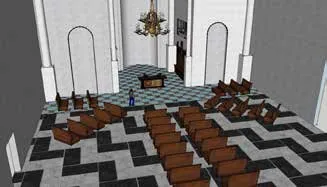
图9 圣马阔拉教堂的模拟场景图,俯瞰图Fig.9 Simulated scene of the Church of San Marcuola,aerial view
圣马阔拉教堂本身是呈东南——西北走向的单殿教堂。不同于其他的教堂,它的主入口并不设置在本堂正后方的西北侧墙面上,而是在与之垂直的东北侧墙面上。《耶稣为门徒洗脚》的构图特点、空间透视特征,都是由于入口和祭坛之间的相对位置而产生的。在图9圣马阔拉教堂的模拟场景图的俯瞰图中,不难找出答案:从入口进入教堂,观看者看向祭坛方向,恰好正对着画面。丁托列托的画面中进行如此奇特的空间设置的原因,一目了然。
The Church of San Marcuola is single-halled, running from southeast to northwest.Unlike other churches, its main entrance is not in the northwest wall, which is right behind the church, but in the northeast wall perpendicular to it.All features of its composition and spatial perspective were caused by the relative positions of the entrance and the altar.It is easy to unveil the answer from an aerial view of the simulation scene of San Marcuola (Fig.9) : upon entering the church from the entrance, the viewer will precisely face the painting when he looks to the altar.The reason why Tintoretto so uniquely designed his space in this painting is now absolutely clear.
注释:
①这是他自己写在工作室墙上的话,原文为:Il disegno diMichelangelo ed il colorito diTiziano。
②本文中涉及的“大画幅”,约指画幅尺寸大于250×250cm的油画作品。
③虽然根据另一个研究丁托列托的专家鲁道夫·帕鲁契尼(Rodolfo Palluchini)的研究,也有证据表明在英国的Shipley Art Gallery的《耶稣为门徒洗脚》才是丁托列托的原作,大多数观点还是认为在普拉多博物馆的才是出自丁托列托之手的原作[2]。
禾 苗:北京大学历史学系2010级博士生
岳中生:中国民航大学副教授
Notes:
1 Inscriptions on the wall of his studio, which was originally: Il disegno diMichelangelo ed il colorito diTiziano.
2 The large-size in this paper refers to a size of an oil painting larger than 250×250cm.
3 Most critics believe that the authorship of the paintingChrist Washing the Feet of His Disciples inPrado National Museum is Tintoretto, though an expert on his works, Rodolfo Palluchini, and some evidence tend to prove that the one with the same title in Shipley Art Gallery is his original.[2]
He Miao, doctoral student admitted to History Department, Peking University in 2010
Yue Zhongsheng: associate professor at Civil Aviation University of China

